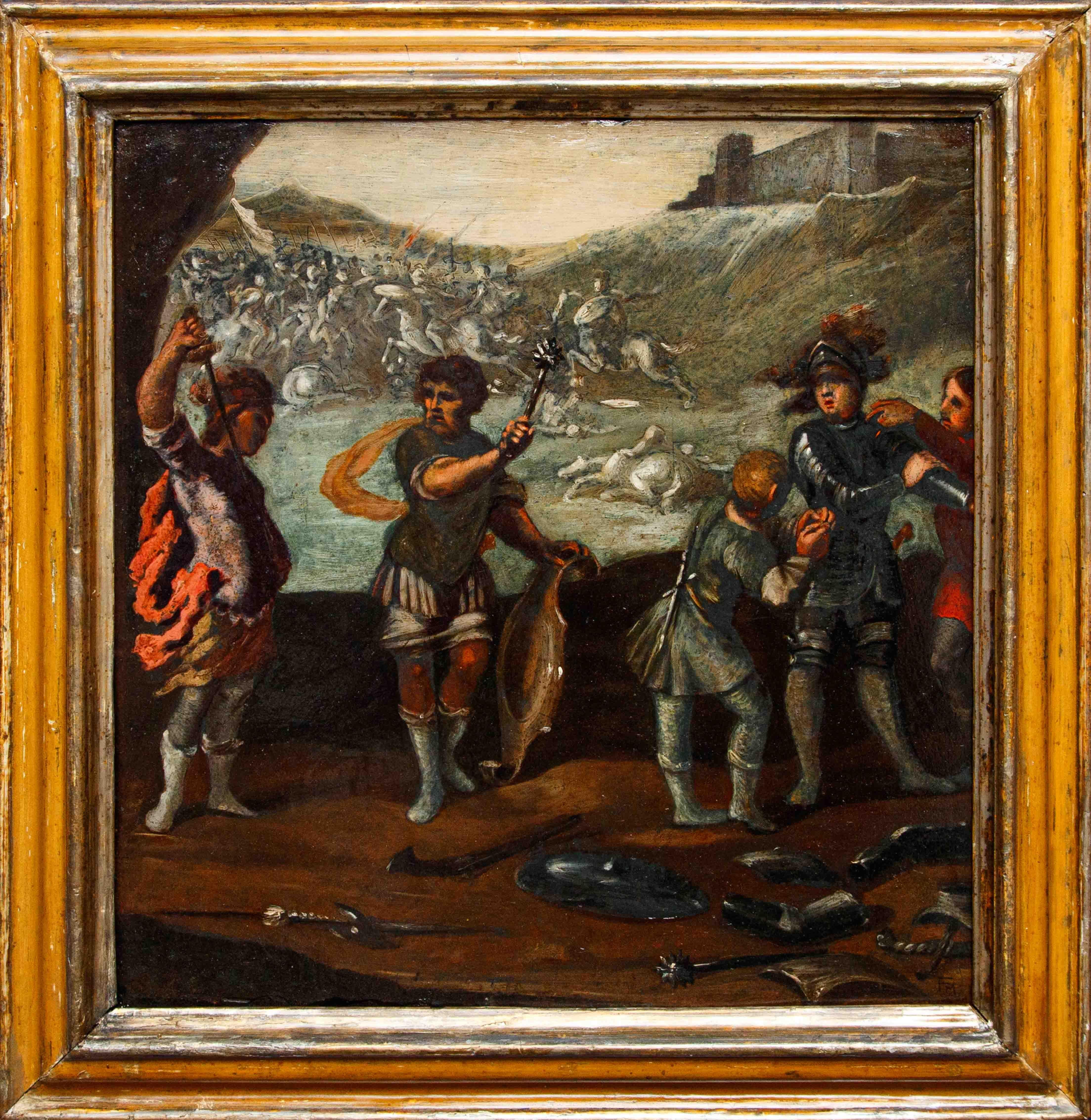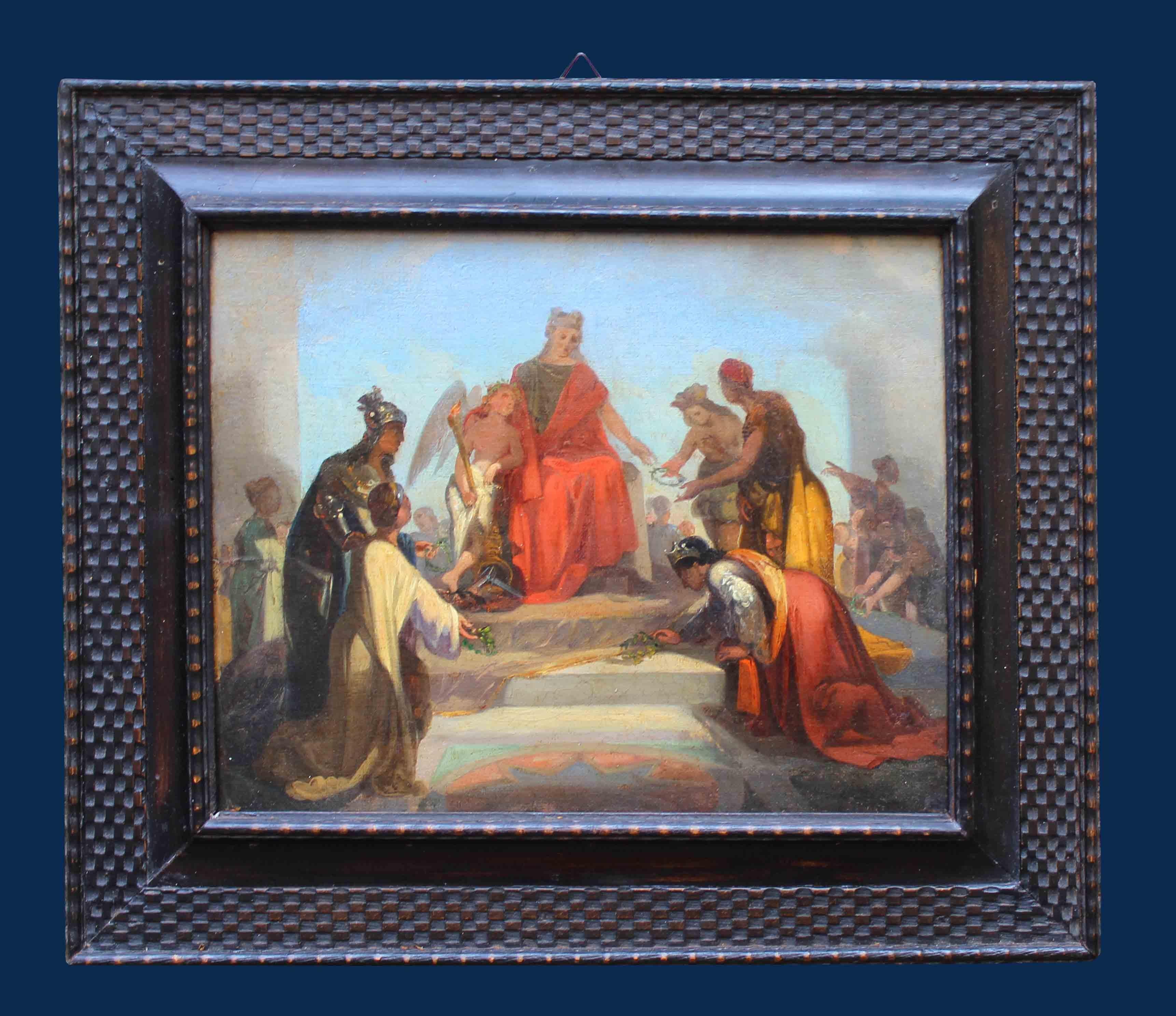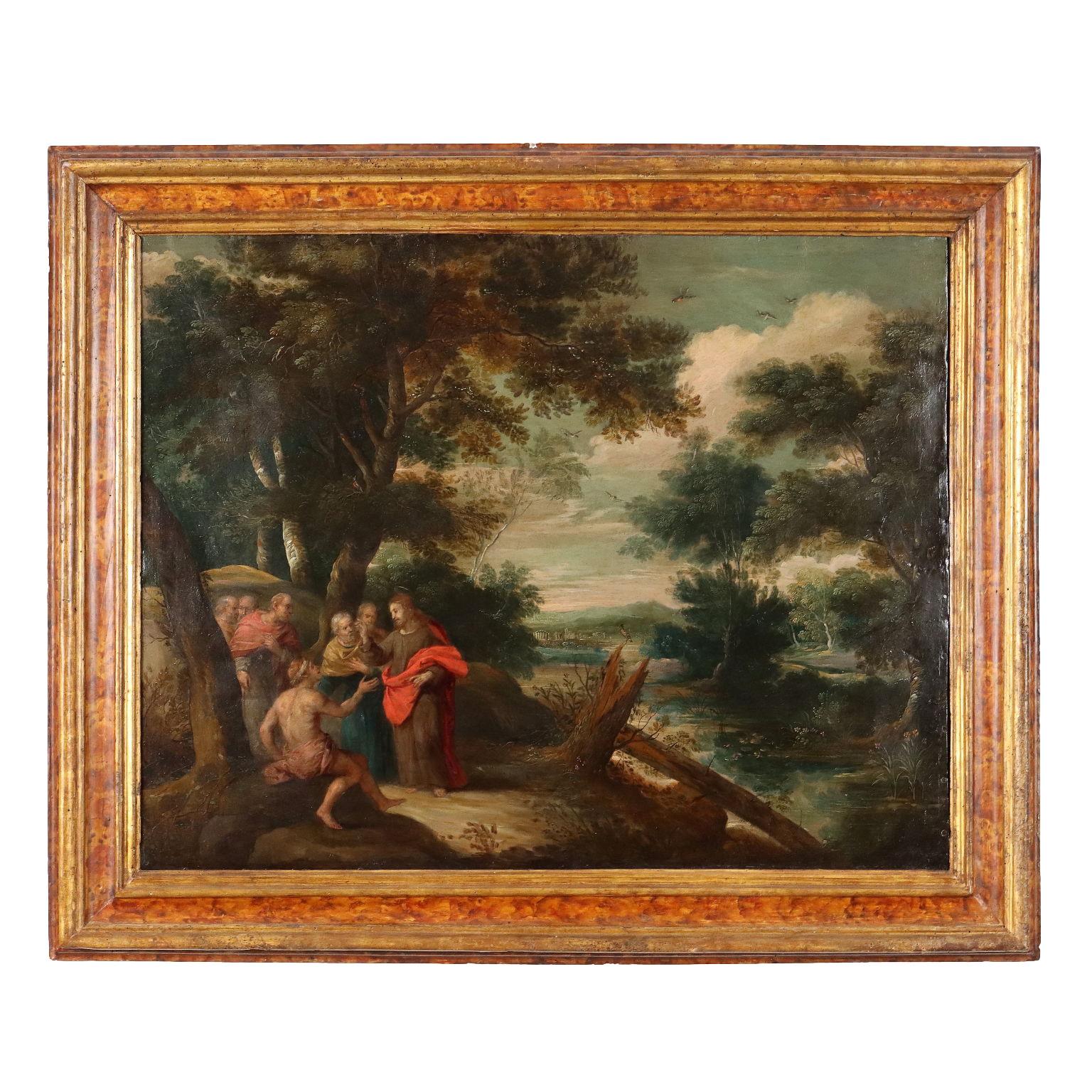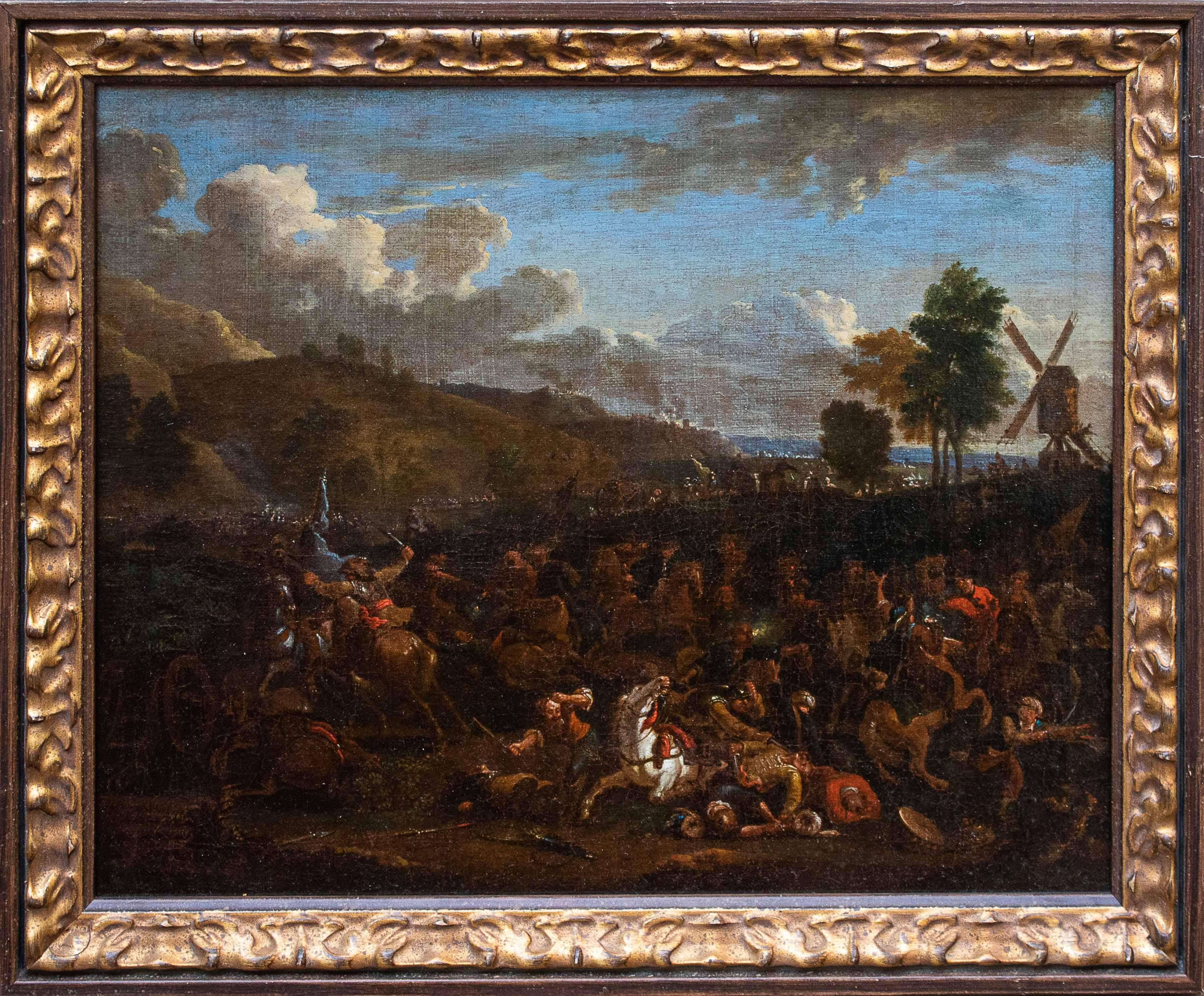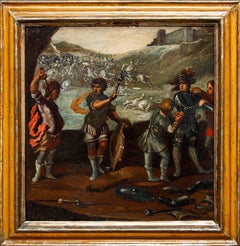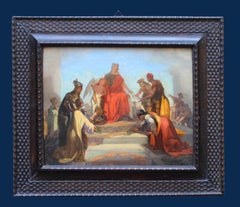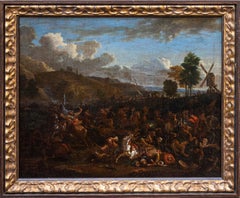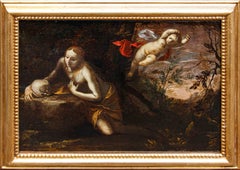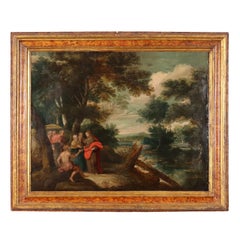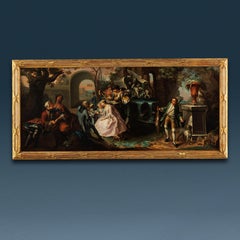Items Similar to Seguace di Jacques Caillot, prima metà del XVIII secolo Salita al calvario
Want more images or videos?
Request additional images or videos from the seller
1 of 12
Seguace di Jacques Caillot, prima metà del XVIII secolo Salita al calvarioXVIII secolo
XVIII secolo
$9,247.98
£6,886.34
€7,800
CA$12,707.23
A$14,221.78
CHF 7,422.68
MX$173,432.45
NOK 95,000.18
SEK 89,929.83
DKK 59,374.57
Shipping
Retrieving quote...The 1stDibs Promise:
Authenticity Guarantee,
Money-Back Guarantee,
24-Hour Cancellation
About the Item
Seguace di Jacques Caillot, prima metà del XVIII secolo
Salita al calvario
Olio su tavola in rovere, cm 33 x 48
Con Cornice, cm 54 x 67
La leggenda narra di un giovane di nobile spirito, Jacques Callot, il quale, animato da un'irrefrenabile passione per le arti figurative, disdegnò i conforti di una dimora agiata per inseguire il sogno di Roma, culla delle muse. Due volte, sfidando l'autorità paterna, si allontanò dal tetto natio per recarsi alla corte del duca di Lorena, dove l'attesa di un'esistenza più consona ai suoi ideali artistici lo invogliava. La carriera di Callot è divisa in un periodo italiano (c. 1609-21) e un periodo lorenese (Francia) (dal 1621 fino alla sua morte). Nel 1608 è a Roma, sotto la guida esperta dell'incisore Philippe Thomassin; qui il giovane Callot iniziò ad affinare la sua tecnica, dedicandosi alla riprouzione di opere maestose, custodite gelosamente nelle sacre dimore della Città Eterna. Con un'acume quasi certosina, egli si immerse nello studio dei maestri fiamminghi e dei raffinati manieristi, assorbendone lo stile e la maestria. La sua carriera artistica conobbe un fulgore inatteso nel 1612, quando fu accolto con entusiasmo alla sofisticata corte dei Medici, a Firenze. In quell'ambiente di squisita eleganza, il talento di Callot trovò fertile terreno. Con un tratto incisivo e un'arguzia senza pari, egli diede vita a un'opera ricca di sfumature, ritraendo scene di vita quotidiana con una veridicità sorprendente: fiere esuberanti, feste opulente, rappresentazioni della commedia dell'arte, figure grottesche e mendicanti, cortigiani vanitosi e gobbi dal volto contorto. Dopo la scomparsa del duca Cosimo II, nel 1621, Callot fece ritorno a Nancy, dove, al servizio della corte lorenese, continuò a dipingere e incidere, dando forma a visioni fantasiose e scene di vita quotidiana. Purtroppo, la maggior parte delle sue opere pittoriche è andata perduta, lasciandoci solo un'eco delle sue straordinarie capacità. A Nancy, l'artista approfondì la sua ricerca artistica, affrontando temi più impegnativi e maturi. Accanto alle rappresentazioni della vita mondana, si dedicò a soggetti religiosi, a composizioni che ritraevano gli orrori della guerra e a paesaggi di struggente bellezza. Nel 1633, profondamente scosso dagli eventi bellici che sconvolgevano l'Europa e dall'invasione della Lorena da parte del cardinale Richelieu, Callot realizzò una serie di incisioni che denunciavano con forza le atrocità della guerra chiamante Les Grandes Misères de la guerre, composti da 18 stampe pubblicate nel 1633. Le sue opere, cariche di un realismo crudo e doloroso, anticipano di quasi due secoli le celebri "Disastri della guerra" di Goya, rivelando una sensibilità e una capacità di analisi psicologica che lo collocano tra i più grandi artisti del suo tempo. Caillot ha saputo sviluppare uno stile naturalistico pur conservando l'artificiosità dell'occasione, organizzando una composizione come se fosse un palcoscenico e riducendo le figure a una scala minuscola, ognuna indicata dal minor numero di colpi possibili. Ciò ha richiesto una tecnica di incisione molto fine. La sua ampiezza di osservazione, il suo stile vivace di figura e la sua abilità nel riunire una grande folla che si muove hanno assicurato per le sue incisioni un'influenza popolare duratura in tutta l'Europa. La splendida tavola qui presentata è la versione più fedele dell’incisione realizzate da Jacques Caillot del medesimo soggetto. Ogni elemento è fedelmente ripreso con abilità e perizia.
- Creation Year:XVIII secolo
- Dimensions:Height: 13 in (33 cm)Width: 18.9 in (48 cm)
- More Editions & Sizes:cm 33 x 48Price: $9,248
- Medium:
- Circle Of:Jacques Callot (1592 - 1635, French)
- Period:
- Condition:
- Gallery Location:Milan, IT
- Reference Number:1stDibs: LU2639216608372
About the Seller
No Reviews Yet
Vetted Professional Seller
Every seller passes strict standards for authenticity and reliability
1stDibs seller since 2023
Typical response time: <1 hour
- ShippingRetrieving quote...Shipping from: Milan, Italy
- Return Policy
Authenticity Guarantee
In the unlikely event there’s an issue with an item’s authenticity, contact us within 1 year for a full refund. DetailsMoney-Back Guarantee
If your item is not as described, is damaged in transit, or does not arrive, contact us within 7 days for a full refund. Details24-Hour Cancellation
You have a 24-hour grace period in which to reconsider your purchase, with no questions asked.Vetted Professional Sellers
Our world-class sellers must adhere to strict standards for service and quality, maintaining the integrity of our listings.Price-Match Guarantee
If you find that a seller listed the same item for a lower price elsewhere, we’ll match it.Trusted Global Delivery
Our best-in-class carrier network provides specialized shipping options worldwide, including custom delivery.More From This Seller
View AllAttributed to Francesco Montelatici called Cecco Bravo, dressing of the knight
Located in Milan, IT
Francesco Montelatici called Cecco Bravo (Florence, November 15, 1601 - Innsbruck, December 1661), attr.
Dressing of a knight before battle
Oil on slate, 48 x 47 cm
Framed, 60 x 5...
Category
17th Century Other Art Style Figurative Paintings
Materials
Stone
Attributed to Hannibal Gatti, Allegorical Scene
By Annibale Gatti
Located in Milan, IT
Annibale Gatti (Forlì 1827 - Florence 1909), attr.
Allegorical Scene
Oil on paper applied to board, 25 x 30 cm - with frame 36 x 42
The allegorical work, by analysis and stylistic...
Category
19th Century Other Art Style Figurative Paintings
Materials
Paper, Oil
Battle scene Oil painting on canvas Attributed to Karel Breydel
By Karel Breydel
Located in Milan, IT
Attr. to Karel Breydel, known as the Knight of Antwerp (1678 - 1733)
Battle with knights and landscape in the background
Oil on canvas, cm 44.5 X 36.7
Frame 52.5 x 45 cm
The pain...
Category
Late 18th Century Figurative Paintings
Materials
Canvas, Paint, Oil
By Giovanni Stefano Danedi, known as Il Montalto
Located in Milan, IT
Giovanni Stefano Danedi, known as Montalto (Treviglio, 1612 - Milan, 1690)
Penitent magdalene
Oil on panel, 34 x 45 cm
Framed, 44 x 57 cm
Provenance: Giancarlo Sestieri Collecti...
Category
17th Century Other Art Style Figurative Paintings
Materials
Oil
Karl Breydel, called The Knight of Antwerp (Antwerp, 1678-1733), Battle
Located in Milan, IT
Karl Breydel, called The Knight of Antwerp (Antwerp, 1678-1733)
Battle scene between Christians and Turks
Oil on canvas, 28.5 x 41 cm
The painting under consideration, consideri...
Category
Mid-17th Century Other Art Style Figurative Paintings
Materials
Canvas, Oil
Lambert de Hondt I (1620–1652), Scene di battaglia
Located in Milan, IT
Lambert de Hondt I (1620–1652)
Scene di battaglia
(2) Olio su tavola, cm 18 x 13
Firma in basso al centro
Le figurette di cavalieri e soldati presenti nell'opera in esame sono p...
Category
17th Century Other Art Style Landscape Paintings
Materials
Oil, Board
You May Also Like
Painting The Preaching of St. John the Baptist, 17th-18th century
Located in Milan, IT
Oil on Canvas. North Italian school of the 17th-18th centuries.
The large scene is filled with figures in ancient Eastern garb, set in a northern, richly vegetated landscape with mou...
Category
Late 17th Century Other Art Style Figurative Paintings
Materials
Oil
Painting Moses Saved by the Waters, 17th-18th century
Located in Milan, IT
Oil on Canvas.
The scene recounts the biblical episode from the book of Exodus in which baby Moses, whom his mother had entrusted to the river inside a basket to save him from the s...
Category
Late 17th Century Other Art Style Figurative Paintings
Materials
Oil
Painting with a Healing Scene 17th Century
Located in Milan, IT
Oil on copper. Flemish school of the seventeenth century.
The painting, attributed by oral tradition to Frans Francken the younger (1581 -1642), depicts a miraculous healing perform...
Category
17th Century Other Art Style Figurative Paintings
Materials
Oil
Gallant party in the park. French School. Mid-18th century
Located in Milan, IT
The scene depicts a feast within a park enclosed by walls with arched gateways opening onto the countryside, and adorned on the right with an amphora on a small column and in the center, behind the figures, with a gushing fountain, with statues of cherubs and shells.
Two couples of richly dressed ladies and gentlemen entertain themselves gallantly, surrounded by servants; one of the men is playing the violin, crouching in front of his lady, who, flanked by the damsel, follows the melody on the score held up by the dark-haired man at her side, while two musicians accompany the playing with flute and a mandolin; the other couple, in an attitude of intimate dialogue, listens on the left, while on the right the hunter returning from the hunt also observes the scene.
Particularly prominent in the scene is the rich dress of the lady in the center, characterized by the wide back folds falling from her shoulders to create a cape. Such a dress corresponds to what was called "robe à la Watteau," named after the French painter Antoine Watteau who first portrayed ladies wearing this pattern.
Antoine Watteau (1684 -1721), a French painter considered one of the most influential French exponents of Rococo painting, was the forerunner of the pictorial genre of gallant scenes, a genre that developed in France from the late 1600s and continued throughout the following century.
The gallant scenes could be considered as the aristocratic version of the genre scene: characterized by music, dances, pleasant conversations between ladies and gentlemen surrounded by servants, they tended to enhance the costumes, fashionable clothes, and environments of the upper class, conveying a kind of detachment from the real times and places, projecting the viewer into an almost theatrical atmosphere of gestures, looks, colors and stage lights.
Moreover, Watteau, along with the Fêtes galantes cycles, also distinguished himself for those inspired by the theater, absorbing his passion for the scenes and characters of that milieu from Claude Gillot...
Category
Mid-18th Century Other Art Style Figurative Paintings
Materials
Oil
Disegno figurativo fiammingo ad acquerello del XVIII secolo, scena di genere
Located in Florence, IT
Sullo sfondo di un paesaggio dai tratti centro-settentrionali europei-in cui si riconoscono una cappella e il profilo di una città dagli alti pinnacoli-si svolge una scena di svago, ...
Category
18th Century Other Art Style Figurative Drawings and Watercolors
Materials
Paper, Ink, Watercolor
The peace of your nights descends into their thoughts
Located in Genève, GE
Work on paper mounted on wood
35.5 x 45.5 x 2 cm
Category
Late 18th Century Old Masters Figurative Paintings
Materials
Oil
